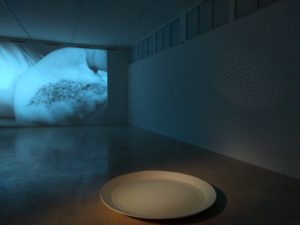 Galleria P420, Bologna, Italy
Galleria P420, Bologna, Italy
http://p420.it
07 April – 02 June 2018
The exhibition “Hypothesis on Infinity” questions about the possibility to extend time into eternity. In addition, spatial borders are another subject. On a whole, the show is a time journey into the late 1960s and early 1970s, when the Italian artist Laura Grisi was first approved by several international solo and group exhibitions.
Even though considered as part of Italian Pop Art, many other artistic discourses are perceptible in the oeuvre of Laura Grisi. Accordingly, the presented artworks could be associated to Optical and Kinetic Art, Minimal Art, Arte Povera or even experimental Film. Furthermore, the oeuvres are influenced by her long travels alienating her from the urban context and where she experienced nature. Nevertheless, she didn’t want to copy nature. She mentioned to her biographer Germano Celant:
“I didn’t want a painting, a sculpture containing air, earth, or water. I didn’t want air, earth, or water to become objects. I wanted to recreate the experience of natural phenomena.”
(Germano Celant, Laura Grisi, Rizzoli International Publications, New York, 1989)
To do so, Laura Grisi used in arts relatively new materials and media. For example, she was one of the first to work with neon. “Sunset Light” from 1967, a pillar of plexiglass and neon light bears witness of that. Yellow and orange light empathises the light colours of a dusk. Though the light is directed diffuse from the rectangular column to the environment. Neither the form of the object, nor the form of the optical radiation repeats the sunlight. Nevertheless, it creates the impression of the light during a sunset.
“Seascape” from 1966, a movable painting shows on one panel a stylised blue sea with horizon, on the other panels appear frames with blue filling. The spectator is invited to change the arrangement and create infinitive water or sky outlooks. Here, the various manifestations of seascapes are suggested. The subject of sky is revived in “Blue Triangles”, the only later work from 1981. Due to the triangle form, the space, where a dove flies is limited. At the same time, the shape is repeated even inside the frames to establish multiple spaces and enclose the bird in an impervious infinite space.
Materials like pebbles and sand are reminding l’Arte Povera. Nevertheless, Laura Grisi featured them with – at the time – relatively new media: in photography and particularly in 16 mm film. In “From One to Four Pebbles” from 1972, she arranged four pebbles in constantly new variations. Shown in a loop, the film is meditative and breaks through the limits of time, since it is a never-ending activity.
Besides, the motive appears once again, but this time in the photo-series “Pebbles” from 1973. In 150 colour pictures, the artist demonstrates the possible combinations of arrangement for five stones in a row. In contrast to the video, the limited possibilities of the medium are outlined, even though the period of observation could be extended eternally.
“The Measuring of Time” from 1969 is projected in large scale in the second room. This 5’45’’ long looped film shows the artist counting grains of sand at a beach. Most of the time, the camera is focussing on one palm with the particles on it and the fingers of the other hand taking single grains and putting it on a pile of sand. Sometimes, the camera moves away to show the whole situation circling around the grain counter and approaches again. Once again, the time is stretched into infinity.
Only one other artwork is installed in the same room: “Drops of Water” from 1968. It is a white flat bowl of 200 cm diameter, filled with water. Single water drops are falling from an installation at the ceiling. The water surface is reflected at the wall. The installation invites to unlimited observation of image and sound. This oeuvre is part of the group of works featuring natural phenomena, in this case, “the sound of water falling into water, to create an environment where one might meditate, listening to the noise of the rain.” (Germano Celant, Laura Grisi, Rizzoli International Publications, New York, 1989). Another possibility to step into infinity.
One might think that the seven artworks of the exhibition could get lost in the huge rooms of the gallery P420. Nevertheless, the opposite is the case: the space between the single works is permeated by the meditative transcendence, transmitted by the oeuvres and their intercommunication.











